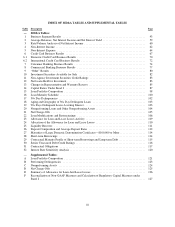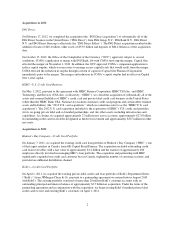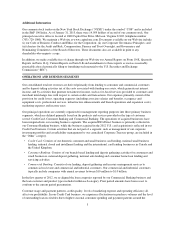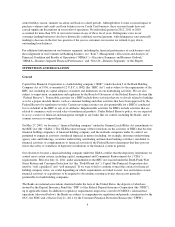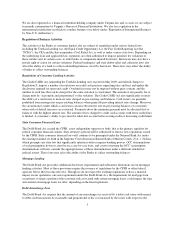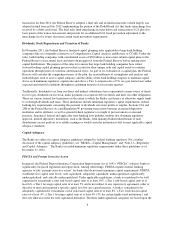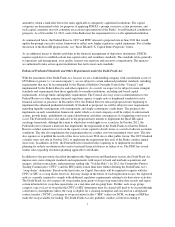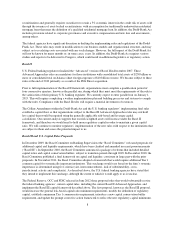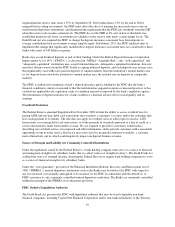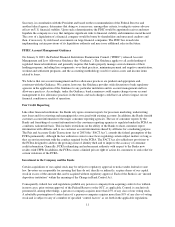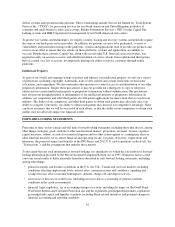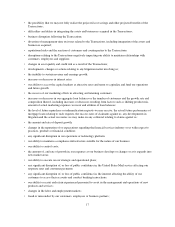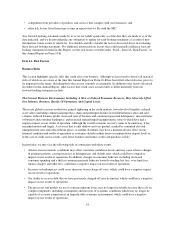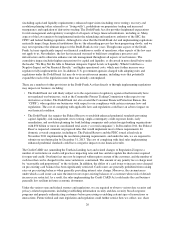Capital One 2012 Annual Report Download - page 29
Download and view the complete annual report
Please find page 29 of the 2012 Capital One annual report below. You can navigate through the pages in the report by either clicking on the pages listed below, or by using the keyword search tool below to find specific information within the annual report.required that the reserve ratio reach 1.35% by September 30, 2020 (rather than 1.15% by the end of 2016);
required that in setting assessments, the FDIC must offset the effect of meeting the increased reserve ratio on
small insured depository institutions; and eliminated the requirement that the FDIC pay dividends from the DIF
when the reserve ratio reaches certain levels. The FDIC has set the DRR at 2% and, in lieu of dividends, has
established progressively lower assessment rate schedules as the reserve ratio meets certain trigger levels. The
Dodd-Frank Act also required the FDIC to change the deposit insurance assessment base from deposits to
average consolidated total assets minus average tangible equity. In February 2011, the FDIC finalized rules to
implement this change that significantly modified how deposit insurance assessment rates are calculated for those
banks with assets of $10 billion or greater.
Banks may accept brokered deposits as part of their funding. Under the Federal Deposit Insurance Corporation
Improvement Act of 1991 (“FDICIA”), as discussed in “MD&A—Liquidity Risk,” only “well-capitalized” and
“adequately-capitalized” institutions may accept brokered deposits. Adequately-capitalized institutions, however,
must first obtain a waiver from the FDIC before accepting brokered deposits, and such deposits may not pay rates
that significantly exceed the rates paid on deposits of similar maturity from the institution’s normal market area
or, for deposits from outside the institution’s normal market area, the national rate on deposits of comparable
maturity.
The FDIC is authorized to terminate a bank’s deposit insurance upon a finding by the FDIC that the bank’s
financial condition is unsafe or unsound or that the institution has engaged in unsafe or unsound practices or has
violated any applicable rule, regulation, order or condition enacted or imposed by the bank’s regulatory agency.
The termination of deposit insurance for a bank could have a material adverse effect on its liquidity and its
earnings.
Overdraft Protection
The Federal Reserve amended Regulation E in November 2009 to limit the ability to assess overdraft fees for
paying ATM and one-time debit card transactions that overdraw a consumer’s account, unless the consumer opts
in to such payment of overdrafts. The rule does not apply to overdraft services with respect to checks, ACH
transactions, or recurring debit card transactions, or to the payment of overdrafts pursuant to a line of credit or a
service that transfers funds from another account. We are required to provide to customers written notice
describing our overdraft service, fees imposed and other information, and to provide customers with a reasonable
opportunity to opt in to the service. Before we may assess fees for paying discretionary overdrafts, a customer
must affirmatively opt in, which could negatively impact our deposit business revenue.
Source of Strength and Liability for Commonly-Controlled Institutions
Under the regulations issued by the Federal Reserve, a bank holding company must serve as a source of financial
and managerial strength to its subsidiary banks (the so-called “source of strength doctrine”). The Dodd-Frank Act
codified the source of strength doctrine, directing the Federal Reserve to require bank holding companies to serve
as a source of financial strength to its subsidiary banks.
Under the “cross-guarantee” provision of the Financial Institutions Reform, Recovery and Enforcement Act of
1989 (“FIRREA”), insured depository institutions such as the Banks may be liable to the FDIC with respect to
any loss incurred, or reasonably anticipated to be incurred, by the FDIC in connection with the default of, or
FDIC assistance to, any commonly controlled insured depository institution. The Banks are commonly controlled
within the meaning of the FIRREA cross-guarantee provision.
FDIC Orderly Liquidation Authority
The Dodd-Frank Act provides the FDIC with liquidation authority that may be used to liquidate non-bank
financial companies, including Capital One Financial Corporation and its non-bank subsidiaries, if the Treasury
10


